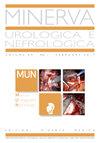Bipolar plasmakinetic transurethral enucleation and resection versus bipolar plasmakinetic transurethral resection for surgically treating large (≥ 60 g) prostates: a propensity score-matched analysis with a 3-year follow-up.
Q1 Medicine
引用次数: 1
Abstract
BACKGROUND There are extremely limited published studies comparing bipolar plasmakinetic transurethral resection of prostate (BP-TURP) and bipolar plasmakinetic transurethral enucleation and resection of prostate (BP-TUERP) for enlarged prostates. Our purpose is to evaluate the safety and efficiency of BP-TUERP and BP-TURP for large (≥ 60 g) prostates with a 3-year follow-up. METHODS We retrospectively identified 229 patients according to inclusion criteria between 2014 and 2016. After applying propensity score matching method, preoperative results and three-year follow-up outcomes in International Prostate Symptom Score (IPSS), urinary peek flow rate (Qmax), postvoid residual urine (PVRU) volume and quality of life (QoL) score were compared. RESULTS Finally, within the well-balanced matched cohort, the BP-TUERP was significantly associated with longer mean operating time (OT) (p = 0.039), shorter mean catheter time (CT) (p = 0.001) and lower mean hemoglobin decrease (p = 0.002) with more prostatic tissue removed (p = 0.001) than the BP-TURP, but the median hospital stay lengths and the short- and long-term complication rates were similar between the two series. The patients in the BP-TUERP group had better long-term outcomes in IPSS, Qmax and PVRU volume than these in the BP-TURP group, but not in QoL score. CONCLUSIONS For patients with large (≥ 60 g) prostates, BP-TUERP and BP-TURP are safe options, but the former is a more effective choice in long-term follow-up outcomes. BP-TUERP is related to reduced CT and hemoglobin decrease with more removal of prostatic tissue at the expense of longer OT than BP-TURP.双极等离子经尿道切除和切除与双极等离子经尿道切除手术治疗大(≥60g)前列腺:一项3年随访的倾向评分匹配分析。
背景:比较双极等离子经尿道前列腺切除术(BP-TURP)和双极等离子经尿道前列腺切除术(BP-TUERP)治疗前列腺肥大的研究非常有限。我们的目的是通过3年随访评估BP-TUERP和BP-TURP治疗大(≥60g)前列腺的安全性和有效性。方法根据2014 - 2016年纳入标准,回顾性筛选229例患者。采用倾向评分匹配法,比较术前结果与3年随访结果在国际前列腺症状评分(IPSS)、尿峰流率(Qmax)、空后残尿量(PVRU)和生活质量(QoL)评分方面的差异。结果最后,在平衡良好的匹配队列中,BP-TURP与BP-TURP相比,平均手术时间(OT)更长(p = 0.039),平均导管时间(CT)更短(p = 0.001),平均血红蛋白降低(p = 0.002),前列腺组织切除更多(p = 0.001),但中位住院时间和短期和长期并发症发生率相似。BP-TURP组患者在IPSS、Qmax和PVRU容积方面的长期预后优于BP-TURP组,但在生活质量评分方面优于BP-TURP组。结论对于大前列腺(≥60 g)患者,BP-TUERP和BP-TURP是安全的选择,但在长期随访结果中,BP-TURP是更有效的选择。与BP-TURP相比,BP-TURP与更多的前列腺组织切除和更长时间的OT相关,与CT降低和血红蛋白降低有关。
本文章由计算机程序翻译,如有差异,请以英文原文为准。
求助全文
约1分钟内获得全文
求助全文
来源期刊

Minerva Urologica E Nefrologica
UROLOGY & NEPHROLOGY-
CiteScore
5.50
自引率
0.00%
发文量
0
审稿时长
>12 weeks
期刊介绍:
The journal Minerva Urologica e Nefrologica publishes scientific papers on nephrology and urology. Manuscripts may be submitted in the form of Minerva opinion editorials, editorial comments, original articles, video illustrated articles, review articles and letters to the Editor.
 求助内容:
求助内容: 应助结果提醒方式:
应助结果提醒方式:


